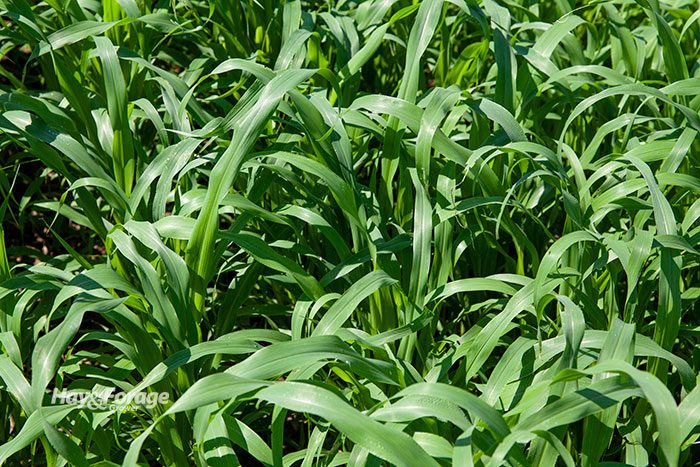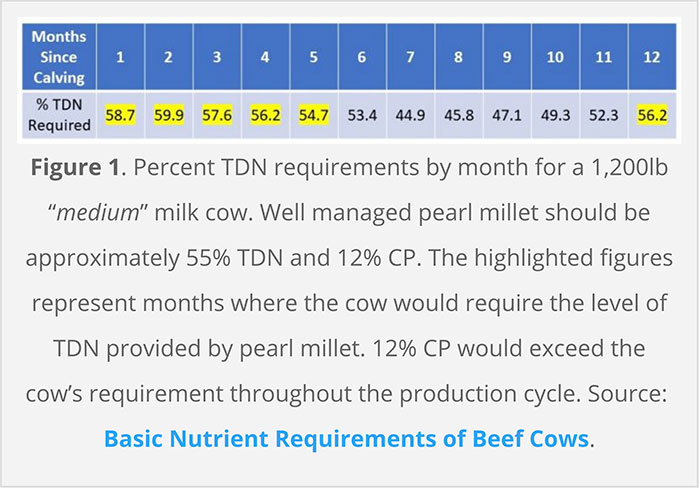
As a warm-season grass, pearl millet is given its due credit for producing ample amounts of high-quality forage when other cool-season species are not, but it is often underutilized on cow-calf operations. The summer annual can be used for hay or silage, but Mark Mauldin, an extension educator in Calhoun County, Fla., addresses its qualities as a grazing forage in the University of Florida Extension’s Panhandle Ag e-News.
“There are periods in a mature cow’s production cycle when pearl millet’s nutritional quality exceeds her requirements,” Mauldin says. He credits this as being one of the reasons that more cow-calf farmers do not graze the forage. The other is the “something else to do” factor of planting and managing the summer annual.
While there is not much to be said about having something else to do when adding pearl millet to the mix of grazing forages, there is a valid point to make about nutrition. As shown in Mauldin’s chart below, the nutrient content provided by pearl millet is appropriate for much of a brood cow’s yearly cycle.

“Feeding brood cows is not the only time that pearl millet fits in to a well-managed cow-calf operation,” he declares. “In several of the following situations, growing high-quality millet can provide cost savings as compared to purchasing off-farm feed.”
• Developing replacement heifers.
• Providing extra nutrition needed to help first-calf heifers breed back in a timely manner.
• Creep grazing nursing calves.
• Grazing weaned calves during preconditioning.
Pearl millet’s preferred growing conditions are an added bonus. If following cool-season annual grasses, there will be no overlap in seasonality.
He explains, “Pearl millet likes warm conditions, minimum soil temperature above 64°F, and minimum air temperatures above 50°F. Air temperatures in the mid-90s are optimum for growth. Pearl millet, planted shortly after cool-season forages play out in the late spring, will stop growing before the earliest recommended cool-season forage planting.”
Setting aside land to rotate with cool- and warm-season annuals will help maximize efficiency; yield per acre will drastically improve, and preparing seedbeds allows for earlier, faster establishment of cool-season grasses.
Mauldin also provides a list of quick facts for farmers to consider when choosing to implement pearl millet into their cow-calf operations.
• Pearl millet can tolerate drought, sandy soil, and moderately acidic soils. It will not tolerate standing water.
• Select dwarf type varieties for grazing situations.
• Seeding rate recommendations vary. Drill about 15 pounds per acre of seed or broadcast 30 pounds per acre.
• Seeds should be planted ½-inch to no more than 1-inch deep.
• Pearl millet needs to be approximately 24 inches tall before grazing. Grazing to lower than 8 inches can greatly slow regrowth or cause plant death.
• Prussic acid poisoning is not a concern with pearl millet, but nitrate accumulation can be an issue.
• Fall armyworms and other foliage-feeding caterpillars can severely damage pearl millet during the growth stage.
Mauldin encourages farmers to consider how incorporating pearl millet into a forage system could benefit your operation. “When I see how fast pearl millet germinates and grows, and how well cattle do on it, I am perplexed why more of it is not utilized on cow-calf operations,” he concluded.

C.J. Weddle is serving as the 2020 Hay & Forage Grower editorial intern. She currently attends Mississippi State University, majoring in agricultural education, leadership, and communications. She grew up on a farm in Vardaman, Miss., where her family raises sweet potatoes and soybeans.

